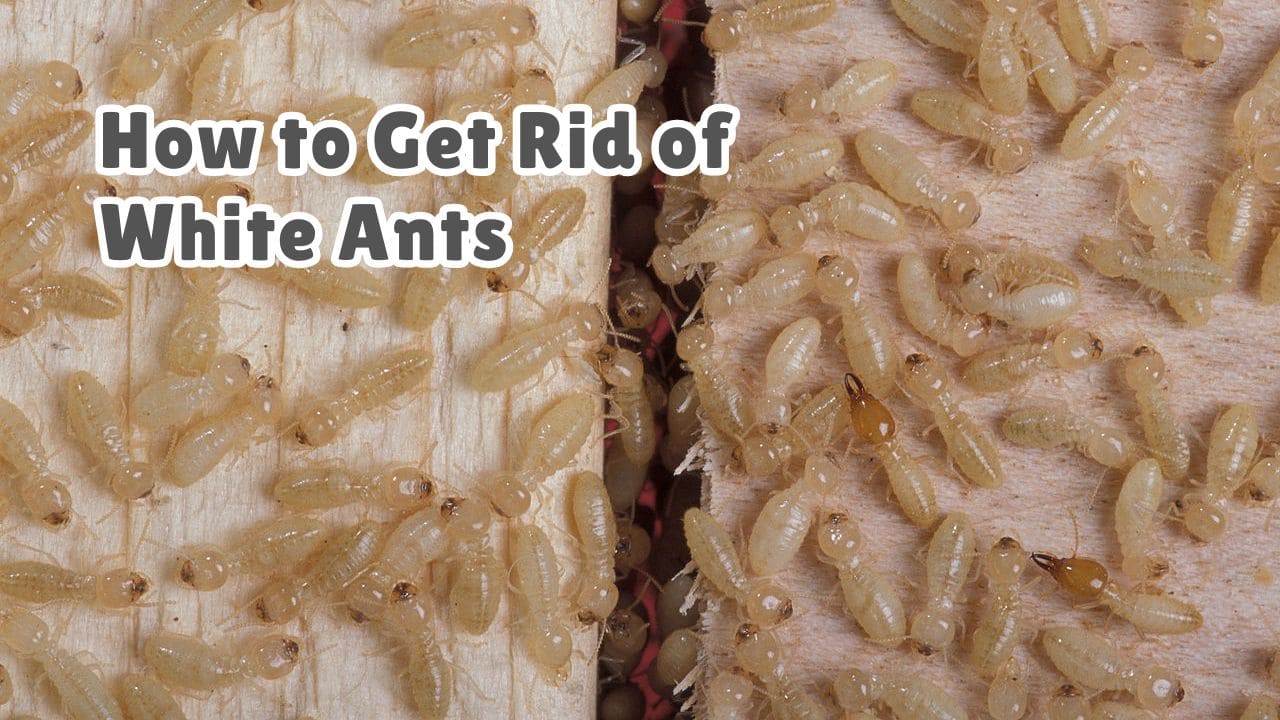Facts about White Ants and their effect
White ants, commonly referred to as termites, are always dreaded because of their destructive tendencies especially when they invade a house. This article will try to focus on different topics related to white ants, including their classification, characteristics, the destruction they cause, and efficient extermination techniques that will allow one to remove them from the house.
What are White Ants? (What are white ants called?)
White ants are more commonly known as termites, and these are social insects under the order Isoptera. However, in spite of the term, ‘white ants’ is not a true ant, as they are considered more closer to the cock roach, in terms of their cousins. In most instances, the term “white ant” is frequently confused with the term “termite” since many termite species, such as the worker termites which tend to have a light colour tone, almost white facet.
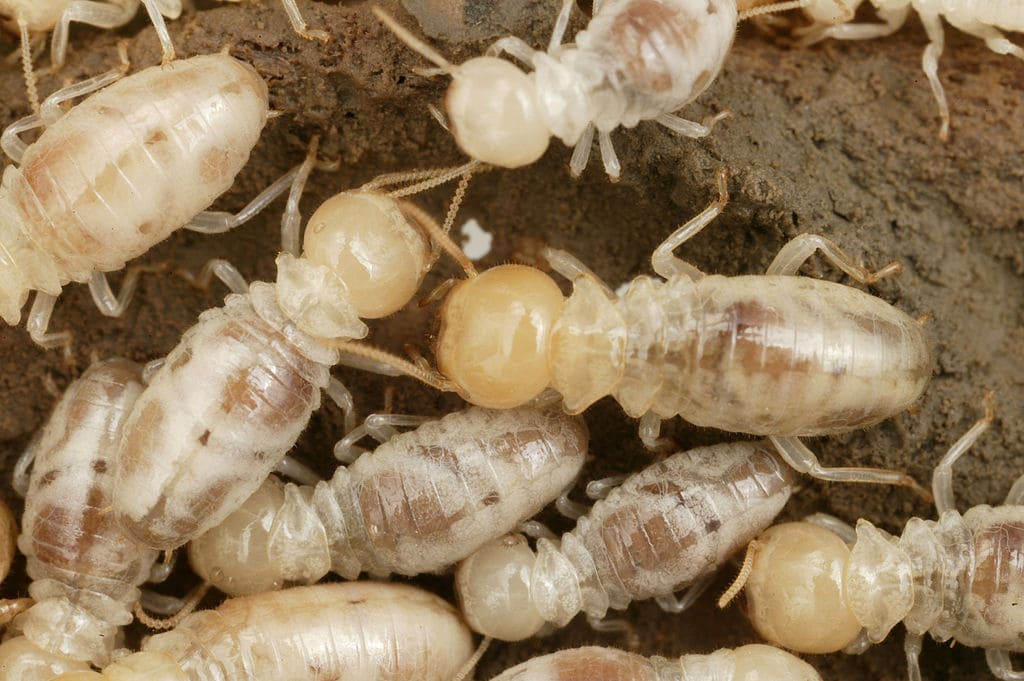
This term confusion may be harmful for the homeowners regarding on pest control, as it is well known that the pest control treatment approaches of true ants are very much different from termites. Therefore, it is highly important to note here that it is critical for pest control efforts to bear in mind that white ants are nothing more than termites.
Pests such as white ants, or termites, perform a vital role for themselves in the food chain by the means of digesting the cellulose present in the much dead plant matter, but when these pests invade your homes – walls and furniture – they can be quite destructive.
Therefore, it is recommended to the homeowners to maintain a watchful eye on signs of disturbance such as mud tubes or the walls or furniture sounding hollow, and seek professional help of pest control to solve the issues if any with White ants.
What do White Ants look like? And, What are their characteristics?
Most white ants are usually between 4 to 10 mm in length. They have a pale white or creamy white color and light brown color and this has made it difficult for people to differentiate them with other bugs. Their bodies do not possess any constriction around the waist and are ants, and have long beads shaped antenna. We summarize their physique in the following pointers;
- Color of Body: White to light cream.
- Shape of Body: Rectangular in shape and no waist.
- Shape of Antennae: Beaded and straight.
- Wings: Where present, both wings are the same and can be easily lost.
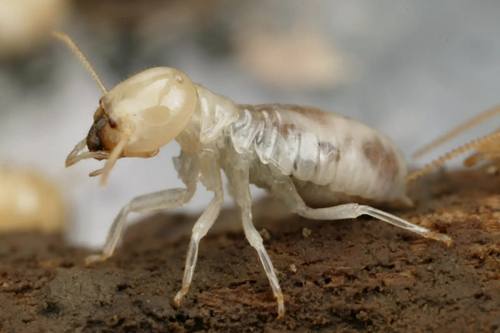
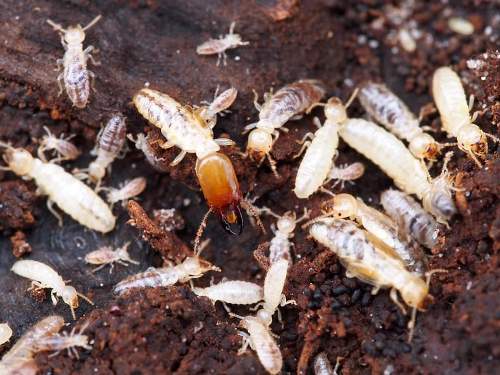
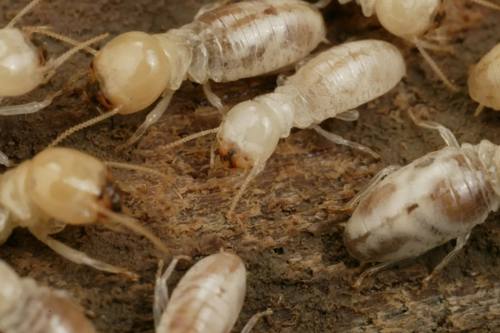
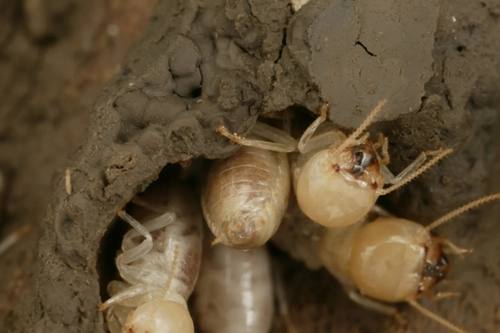
White Ants vs Termites
The expressions ‘white ants’ and ‘termites’ are used in the same breath quite often. But it is necessary to note that all white ants are termites but not all portions of the termites can accurately be called white ants. In fact, people face confusion because they see the white ants, who are not really ants in the first place, many of the species of the termites tend to look very similar to ants and thus the nickname became prominent.
Where are the White Ants found? | Where do White Ants live?
The life of the white ant’s normally calls upon moist habitats. They draft nesting areas within:
- Soil: Sub-termites build complex network of nests throughout the soil.
- Wood: They attack living and dead trees and any wood within the house as well.
- Damp Areas: Common places are wall spaces around leaking pipes or damp cellars.
The presence of white ants in wood can be detrimental to buildings and therefore needs immediate elimination for the homeowner. Most people refer to them as small white ants or white tiny ants and these pests tend to prefer damp places where there are wooden items. When white ants in wood are left unchecked they end up sucking the insides of beams, furniture, amongst other wooden parts, this brings about expensive repair bills.
Knowing what to look out for, such as mud tubes as well as wood sound impressions that are hollow assists in the management of the pest problem. Whenever there are signs of these small white ants in the house always check the basement or if there are any wet areas around plumbing.
Many bodies focus on chemical treatment designed for white ants to solve the problems with white ants in wood. The chemicals are specifically aimed at destroying colonies of the small white ant from infesting the wood. White ants can easily infest our homes and if a chemical for white ants that is safe for indoor use is used, we can prevent white ants infestation.
Consistent usage of these chemicals will provide a barrier against colonies of white tiny ants to invade your premises and hence provide shelter of such colonies which can cause a huge amount of destruction due to the feeding even death to most plants. Homeowners who want to eradicate white ants in wood must combine preventative measures with chemical treatment of wood.
Signs of Infestation of White Ants in house
The most important thing about white ants is their propagation. If one acts quickly, damage can be limited. The following are the common signs of them:
- Mud Tubes: With soil and saliva these tunnels allow movement between nests and food sources.
- Wood Damage: Drummy wood or any timber with damaged timber.
- Torn Wings: Certain parts like windows or other openings repel wings which means the termites after months of waiting have finally swarmed.
Getting Help with the Infestation of White Ants in the House
How to get rid of white ants in the house?
Tackling the problem of white ant infestation has to be deliberate because they are capable of causing severe structural damage in a short period. The following describes ways through which white ant populations can be controlled:
How to stop white ants? | White Ant control treatment
Chemical Treatments
- Termiticides: These are defined as insecticides used to eradicate termites to death upon contact or after eating them and can be sprayed around the house or into the wood directly.
- Baiting Systems: Workers are able to carry the insecticide into the colony, where it kills the queen and other termites, ultimately leading to the colony’s demise.
Natural Remedies
There are a number of alternatives that are effective and do not present any threat to one’s environment as compared to the pesticides precedingly discussed:
- Boric Acid: This can be used directly to the affected portions or in the sugar water that has been drunk by white ants in the affected areas.
- Essential Oils: Essential oils can also affect the behaviors of termites preventing them from infesting your home such as through the use of orange oil or neem oil.
Preventive Measures
There are various approaches that can be taken to avert any further infestations:
- Regular Inspections: Collaborate with a pest control service for at least one inspection a year to ensure everything is fine.
- Moisture Control: Attempting to restrict excess moisture in the environment by ensuring that there are no leaks or proper drainage is available will help.
- Wood Treatment: Construct all wood with treated wood and ensure wooden structures do not come into direct contact with the soil.
Natural remedies to get rid of white ants in the house
How to get rid of white ants naturally?
To deal with the white ants (termites) infestations, some measures can be safely taken that will assist in fighting the termites without harming the environment. Here’s a well detailed discussion on the best natural means to eliminate white ants from your house.
Natural treatment without any use of chemical for white ants
(Natural remedy for White ants)
1. Boric Acid
This is one of the natural remedies which clinically has been shown, when used properly, it is effective against termites. When boric acid is consumed by a termite, it disturbs it intestinal flora making its ecological balance unstable and subsequently killing them due to starvation.
How to Use:
- One teaspoon of boric acid is dissolved in one cup of warm water and fills the mixture spray bottles.
- The very first and the most easy way out is to spray this mixture on the infested wood and spots that look potentially termite prone.
- Measurement may not be that accurate, immerse wooden sticks or cardboards in the mixture and keep them around the infested areas that may attract the feeding termites.
2. Vinegar Solution
Another natural remedy known to be effective on termites is the solution made from the white vinegar and lemon juice, this is effective because of acetic acid which is a key ingredient in the remedy.
How to Use:
- Lemon juice can be added to the mixture as well, making it a perfect solution by combining half and half ratio of water and white vinegar.
- A more direct approach would be spraying the mixtures on the mud tubes, visible termites and infested wood.
- Keep doing this every day until you have stopped noticing the presence of termites.
3. Diatomaceous Earth
Diatomaceous earth (DE) is made from fossilized algae and is an organic powder. When insects have the opportunity of coming in contact with it, they die because the powder dehydrates them.
How to Use:
- Place food still containing diatomaceous earth near termites or sprinkle it on areas around the termites.
- Dryness is crucial for effectiveness, as dampness can lower efficacy.
4. Neem oil
Neem oil, which is an insect repellent, is extracted from neem tree seeds and has the effect of damaging the hormone systems in termites which in turn stops them from eating or breeding.
How to Use:
- Use neem oil while diluting it with water, two tablespoons are mixed with one gallon, and direct it onto the parts that are affected.
- Repeat the application on a continuous basis until the level of infestations reduces.
5. Orange Oil
D-limonene, a primary compound in orange oil and is well known to be harmful to termites. It causes destruction to the outer skin layers and interferes with their metabolism.
How to use:
- Use water to dilute concentrated orange oil in a predetermined ratio that is stated in the instructions of the product.
- The solution can be sprayed on surfaces that have been infected by termites as well as unexplored woody areas in your house.
6. Salt Water Solution
For small infestations, salt is a great natural remedy since it causes dehydration to the white ants.
How to Do it:
- Add salt to warm water, the more salt the better (high concentration works best).
- Spray or pour this solution around places with infested white ants, especially near wooden structures.
7. Trap with Wet Cardboard
Cardboard is made of cellulose which attracts white ants encouraging them to infest it hence making this method very effective.
How to Do it:
- Take a few pieces of cardboard and wet them before putting them in areas suspected of white ant activity.
- When the cardboard is teemed with the termites, pull out the cardboard and burn it to get rid of the white ants in the house.
8. Cayenne Pepper
Cayenne contains a compound called capsaicin which is very damaging to the nerve system of the white ants hence killing them.
How to Do it:
- Combine cayenne pepper powder with water and use it as a spray.
- Once every week, spray this mixture on the white ants or around the affected areas.
9. Exposure to Direct Sunlight
White ants prefer shady places, thus an effective way to remove them is exposing them to sunlight.
How to Do it:
- When able, take outside the infested furniture into direct sunlight for a couple of hours.
- For furniture not able to move, lights with UV rays can be used to spot the required place.
10. Nematodes
Good nematodes are beneficial microscopic worms that feed on white ants, and do not harm people or animals.
Directions for use:
- Get Nematodes from garden center and add them to water according to the instructions given.
- This mixture should be put on infested places as the nematodes will go after the white ants and kill them.
The use of these natural remedies for white ant treatment can be very useful in controlling the colonies of white ant without the need for stronger chemicals. Periodic surveillance and using these methods will effectively help in preventing white ants from invading the house. Always bear in mind that effort is the magic word; several applications may have to be made for full removal of white ants from the house.
Must Read,
✔️ Original Rudraksha: How to Identify Original Rudraksha?, Rudraksha Types and Test Methods
✔️ What is Guggul: Benefits, Uses and Side effects
Conclusion
Given their wood-eating tendencies, it is clear that white ants are a danger to houses. It is of utmost importance that house owners learn about their patterns, notice the first signs of infestation before it gets out of control, and take relevant and timely corrective actions. Whatever option one decides to take whether it is a chemical or natural one, fast response to a white ant challenge will ensure the safety of one’s house against these unwelcomed guests.
Maintaining some basic inspections and taking relevant and basic measures will ensure these pests do not inhabit one’s house in the foreseeable future.
Frequently Asked Questions (FAQs)
-
Do white ants eat treated pine?
Although treated timber may help provide some protection against white ants (termites), it is largely effective for only a certain period and even the pressure-treated lumber is not resistant. Treated pine must be regularly checked for signs of termite activity because while it offers certain protection, it is not completely immune. As time passes, the effectiveness of the treatment can wear off and become less effective due to various weather conditions and moisture.
-
How do white ants look like?
White ants are soft-bodied insects that are pale or creamy-white in colour and do not possess the hard exoskeleton that most insects do. The average white ant is between 4 to 10mm long, and its beads are tipped by straight antennae. True ants have very slender waists, unlike white ants, which are elongated and have an even width throughout the body. Certain types of white ants may also be light-brown.
-
What are white ants how are they harmful?
White ants are also called termites, and they are social insects that form colonies. Their most common survival food includes cellulose that is derived from wood, paper, and other plant components. This undisciplined chewing can lead to considerable structural damage to homes. One of the most common nuisance among homeowners, white ants can do a lot of damage in a matter of short time, often times gouging support beams and other vital wooden material.
-
Are all white ants termites?
A white ant is a term that is specifically focus on particular types of termites that are pale in color, so yes all white ants are one type of termites. Termites do not share any biological similarities with true ants despite being under one class and sharing some behavioral aspects that allow them to survive in colonies.
-
Are termites and white ants the same?
Yes, a white ant is a pale, type of termite, hence the two insects’ names are often used interchangeably. Unfortunately, the white ant name is slang terminology that described termites based on their appearance. The two terms explain the same social insects that can be destructive as they feed on wood which is a valuable constituent material of many household structures.
-
Do black ants eat white ants?
In a sense, black ants may consider white ants which are actually called termites as a snack as black ants may attack them but such instances are extremely rare. Ants in general detail have some very different characteristics so in most scenarios tend to consume different types of substances, black ants are known to eat more sugary products and thus are less likely to collide with the diet of termites.
-
How to kill white ants at home naturally?
If you have termites in your house and are looking for effective and natural ways to kill them, then one page solution to this problem are the following points.
Boric Acid: Combine sulfuric acid with sugar and sprinkle it around the affected area.
Diatomaceous Earth: Spread some Diatomaceous earth around the place or leave them on dust as they end up drying out the ants or termites.
Vinegar: In Intermediate wood paste some vinegar and water which ends up affecting the termites directly and for successful results repeat this procedure daily increasing the dosage gradually.
Neem Oil: Combine one part of neem oil with three parts of water and easily spray it on the areas which are nasty with termites. Using such treatments on a regular basis can help keep termite numbers under control without using harmful chemicals.
Furniture Isolation: Try to put the mattress and sofas outside in the sun for several hours if the condition allows.
Seek Expert Assistance: Depending on the gravity of the infestation, you may want to try and get in touch with certain professionals for pest control services. -
How to remove white ants from furniture?
In order to treat and damage such white ants which infested your wooden chairs or table, here is a do it yourself guide which may enable you to do so in a very effective manner.
Inspect thoroughly: The first step is examining the piece of furniture infested and if you are able to find ants chewing or burrowing within it, you may hear sounds which are tapping like.
Use boric acid: Get yourself some Boric acid and use it by combining it with sugar so that the mixture is easy to chew on and place it in the areas where you find piles of such ants.
Diatomaceous Earth: In order to finish off those colonies which dig holes within the wood, sprinkle around in such colonies food grade diatomaceous earth. -
Are there materials other than wood that can be damaged by termites?
The answer is affirmative, white ants (termites) are able to damage materials in addition to wood. Apart from wood, these pests are known to consume all structural cellulose, including textiles, many paper products, and a few varieties of insulation. Termites can also cause damage to soft plastic materials and foam insulation.
Coupled with these findings, some have been described to have chewed away electrical insulation and rubber tires. This adaptability in feeding habits means these pests are able to cause much havoc to a home and any kind of building.
-
What measures can be taken to keep termites out of the house?
When looking to keep termites or white ants out of the house, one of the primary steps should be source of moisture removal the level of humidity should be quite low as these pests perform well under humid environments. Ensure that your property has good drainage and correct any plumbing leaks around. You can also make sure that wooden materials in fiberglass decks or sidings do not connect with soil by keeping an adequate space.
It is also important to lookout for signs of white ants more commonly known as termites, such as mud tubes on concrete slabs or mostly wooden materials which sound more hollow than usual. Also consider using physical insect barriers such as metal mesh, or consider chemical treatments designed to protect the area surrounding your home from termite infestation.
-
What are the most common places to find white ants in wood?
Wood that has decayed or has been subjected to moisture is a likely place to locate white ants. Common spots include wall cavities that are located behind leaking pipes, wooden posts in the basement, and indeed timbers in structural walls and ceilings of buildings. They construct mud tubes along or within the soil or structure of wood to reside in wooden structure. In chewed wood, they may also infest with wooden items such as furniture and decks or fences.
-
What are the potential side effects of using boric acid indoors?
While using boric acid treatment for wood furniture and structures inside the home, care should be taken since it has a few drawbacks, when used incorrectly.
Even though it is quite common for homes infected with insects to use a boric acid solution accurately, upon inhalation of such substances it might cause trouble for the lungs and respiratory tracts. Physical contact or use with such substances often causes irritation and in some cases allergy.
In worse case the consequences are severe, ingesting such substances may lead to a toxic effect, putting an unborn child and pets at risk causing nausea, vomiting or diarrhea. This leads to sound practical use of such items ensuring they’re out of arms reach.


